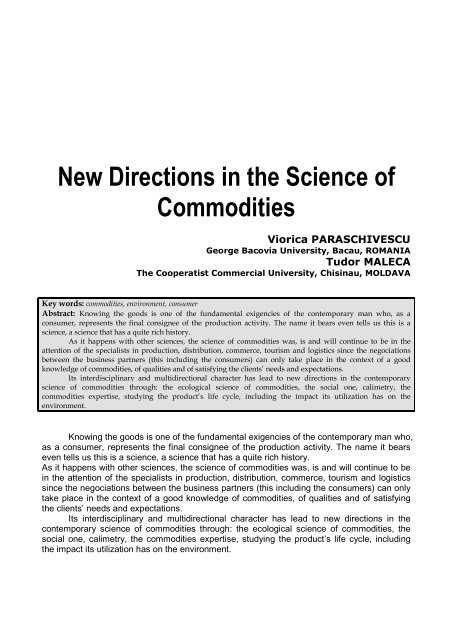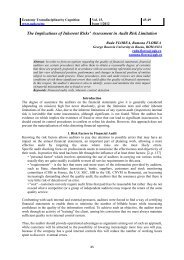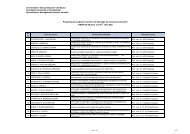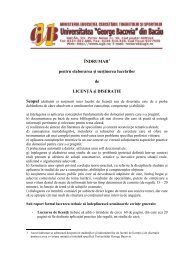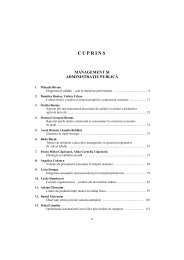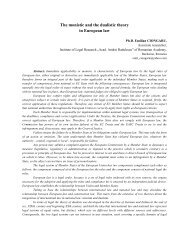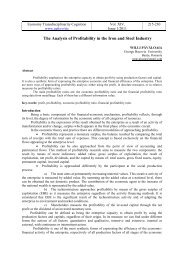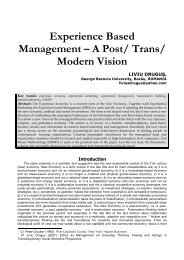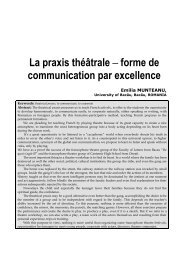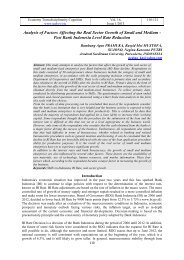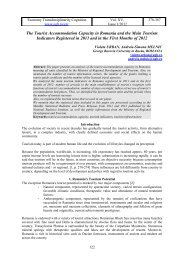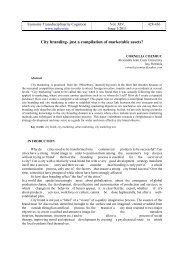full text - Universitatea George Bacovia
full text - Universitatea George Bacovia
full text - Universitatea George Bacovia
Create successful ePaper yourself
Turn your PDF publications into a flip-book with our unique Google optimized e-Paper software.
New Directions in the Science ofCommoditiesViorica PARASCHIVESCU<strong>George</strong> <strong>Bacovia</strong> University, Bacau, ROMANIATudor MALECAThe Cooperatist Commercial University, Chisinau, MOLDAVAKey words: commodities, environment, consumerAbstract: Knowing the goods is one of the fundamental exigencies of the contemporary man who, as aconsumer, represents the final consignee of the production activity. The name it bears even tells us this is ascience, a science that has a quite rich history.As it happens with other sciences, the science of commodities was, is and will continue to be in theattention of the specialists in production, distribution, commerce, tourism and logistics since the negociationsbetween the business partners (this including the consumers) can only take place in the con<strong>text</strong> of a goodknowledge of commodities, of qualities and of satisfying the clients’ needs and expectations.Its interdisciplinary and multidirectional character has lead to new directions in the contemporaryscience of commodities through: the ecological science of commodities, the social one, calimetry, thecommodities expertise, studying the product’s life cycle, including the impact its utilization has on theenvironment.Knowing the goods is one of the fundamental exigencies of the contemporary man who,as a consumer, represents the final consignee of the production activity. The name it bearseven tells us this is a science, a science that has a quite rich history.As it happens with other sciences, the science of commodities was, is and will continue to bein the attention of the specialists in production, distribution, commerce, tourism and logisticssince the negociations between the business partners (this including the consumers) can onlytake place in the con<strong>text</strong> of a good knowledge of commodities, of qualities and of satisfyingthe clients’ needs and expectations.Its interdisciplinary and multidirectional character has lead to new directions in thecontemporary science of commodities through: the ecological science of commodities, thesocial one, calimetry, the commodities expertise, studying the product’s life cycle, includingthe impact its utilization has on the environment.
The object of the science of commodities has continuously evolved, both in form and incontent, but its essence has remained constant even from the first books of the pioneers ofthis science, in Italy (Balducci Pegoloti) and Germany (Johann Beckmann). In the first<strong>text</strong>book on the science of commodities that appeared in Romania in 1885, professor ArsenieVlaicu defined this science as being the “study of the origins of products, of their essentiallychemical and physical properties, of their authenticity and quality indexes, as well as of themethods used to establish these qualities and to discover the deterioration and falsification ofthe merchandise”.The importance of knowing the science of commodities has been syntheticallyexpressed by the Japanese professor Yoshiro Iijima. “the education in the science ofcommodities has contributed a lot to commercial education and to industrial development inJapan, playing an important role in the field of internal education, of the education of theconsumer and generally speaking, in social education.”There are a lot of significant proofs of the international acknowledgement of theimportance borne by the science of commodities:• Starting from 1975 there appeared the International Association of the Technology of theScience of Commodities, with its headquarters in Wien.• There are national associations of commodity studies in many countries of the world• There are several publications in this domain: Forum Ware, IGWT, Studies of commodities,Japan , Italy• There are faculties and specializations in the science of commodities in many Universitiesfrom Italy, Japan , Austria, Romania, The Republic of Moldavia, Poland, Russia, Ukraine• The science of commodities is studied both in schools and universities• It is a specialization for doctor’s and master’s degree• The study of commodities is and has been part of numerous international scientificmanifestationsNowadays, the science of commodities heads to the following main directions in research:• The multi-directional research of the goods (from a technical, economic, ecological andsocial point of view)• The research of the goods all along their trajectory, considering even the phases beforeand after their utilization• Engaging in activities meant to form the ability to differentiate goods according to theirquality, etc.The thematic of the international study of commodities deals with a great variety ofissues, like: defining the contents of the categories of the science of commodities and of thequality study, the connections between the science of commodities and other sciences,classifying the types of goods according to scientific criteria, modern methods of studying themerchandise, the implications that the usage of synthetic raw materials have on quality, theimplications of the latest technologies, raw materials and packing techniques, marking andlabeling merchandise, finding out the fakes, the relation between quality and environment,packing and environment, product and environment, consumer and environment, quality andconsumer, certification, expert examination and checking on delivery.The science of commodities is a domain that is eminently practical and interdisciplinary,allowing correlating the natural reserves and the stocks of raw materials with technologicalprogress and the production capacity, with the economical development and environmentalissues, offering elements which are indispensable when making rational and non-emotionalchoices between the goods that are sold on the market. The domain of the science of
commodities is closely connected to the evolution of goods and the methods of turning togood account contemporary merchandise on the market.Nowadays, in the science of commodities, conceptual and methodological reshapingtake place, a special importance being given to promoting an integrating vision of the product.This means, first of all, a multi-directional approach of the goods, taking into accountsnot only the technical and the economical aspects, but also the social and ecologicalimplications of the products and of the logistics. Normally, the science of commodities is moreand more oriented towards studying the products all along their trajectory, paying attentioneven to the pre and post existential phases of the product.The interdisciplinary and transdisciplinary character, the multidirectional researchintroduced in the modern study of commodities are concepts that are shared nowadays bothby worldwide known personalities like G.Grundke (Germany), W. Ciusa (Italy), J. Holzl(Austria), G. Nebia, C. Calzolari, O. Gekeler and so on, as well as by the Schools ofcommodities studies created by ASE Bucharest and UCCM Chisinau.The thematic approached by the study of commodities is very wide and is at theboundary of mannier classical and modern disciplines, from which it takes concepts, methodsand techniques of analyzing quality and the type of products that are being sold, adaptingthese methods to its domain of study. The science of commodities will live as long as therewill be merchandise on the market, hence….forever. (Stanciu, 2002). According to the ItalianEncyclopedic Dictionary “contrasting the simplicity of its name, the science of commodities isone of the most complex and wide sciences”. Therefore, commerce is done with merchandise,and merchandise is studied by the science of commodities. Approaching merchandise in a bicomponentsystem (product-pack) or three-component (product-pack-environment) amplifiesthe conceptual and informal message of the science of commodities.The modern orientation of the object of this science is circumscribed in the field of knowledgethat is directly or indirectly connected to the quality and class of products.In the past twenty years important progress has been recorded in the field of definingand solving the practical aspects of improving, standardizing, certifying, providing,guaranteeing, analyzing, assessing and presenting the quality of products and logistics.The amazingly rapid evolution of the internationalization and world-wide opening of themarket, through the most complex forms and structures, also brings along new problems ofnotional and terminological communication, regarding ecological products and packs,environmental safety, durable evolution.According to the diversification and growth of the complexity of the products, of thepointing out of the interdependence between merchandise, man and nature, the new scienceof commodities has taken into account new implications of the merchandise, such as thesocial and ecological and even juridical ones (this meaning respecting the consumer’s rights,the settlement and standardization aspects, the guarantee and the certification, etc).From the multiple aspects of the new science of commodities we shall approach theecological science of commodities, as a new domain of the contemporary one.As expected, the consumer-oriented “green” movement has urged the amplification ofthe preoccupation the science of commodities has regarding a certain category of productsthat is the ecological ones. Hence, marketing did not remain behind and developed theecological marketing. Moreover, the educational system introduced in its curricula theproblematic of environment: the management of the environment, environmental strategies,the management of the wastage, durable evolution, ecological products and logistics, etc.It is obvious that we need ecological products, but we must take into account both theadvantages and the disadvantages (costs, influences, lack of education) the ecological
product is still hard to “control”. And here we mean the fact that very few products or logisticsare <strong>full</strong>y ecological (not even the products used for recycling are completely ecological) andbetween the intention and the practical activities there still is a phase difference. At theinternational level it can be seen that the scientists have noticed that there is a global problemof health and environment, and they want to do something in this respect. The experts incommodities have already started their research in aspects regarding durable development intwo directions: the ecological impact of the existing products and packs and the study of new,ecological products.A fundamental change of perspective must be made also regarding the consumer’sopinion. Their ecological awareness wills determine restatements in the usual problems of thescience of commodities, marketing and management, and even politics. The actualmanifestation and inducement of the request for ecologic products and logistics is done byinforming the consumers through a process of continuous communication between thecompany and the market, so that, step by step, the consumer will change his usual behaviourbecoming a responsible consumer. Europe’s Plans for Environmental Actions mention thesocial utility of the consumer, thus naming his responsibility for present and for the future.Referring to the companies’ responsibility towards the environment, Hawken (The Ecology ofCommerce. A Declaration of Sustainability,1997) mentions three types of activities: what docompanies take, produce and waste. What they take refers to the raw materials and theresources they take from the ecosystem. What they do deal with the products and theservices they obtain and offer for commercialization and that can affect the environment.What they waste are the ecological costs, defined by the collective costs associated both tothe businesses and to the clients, and to the company as a whole. These are: pollution,wastages, the depletion and the destruction of the natural system.The ecological science of commodities already comprises some food, <strong>text</strong>ile, cosmetic,chemical and electrotechnical products, and so on. Nowadays, attention is mostly payed tofood products, but we are far from having approached all the range of products and theproblematic of the science of commodities related to the environment.Nowadays, the sixth generation of food products is coming out. These are the ecologicproducts.The evolution of the food product from the natural one, more or less physically,chemically or biochemical modified to the complex food product obtained through newtechnologies, non-conventional raw materials, ultra-refined substances and chemicaladditives was accompanied by the apparition of unwanted metabolic effects induced by byfood disequilibrium.This has lead to the act of becoming aware of the importance of the act of nutrition andhas also determined the consumers and the producers to focus on foods with a declarednutritional value and as biologically pure as possible.The need to stimulate the action of producing, processing and selling “bio” productshas opened a new preoccupation to the science of commodities, this being the science thatstudies merchandise as assets to be used.Today, the ecologic food products are considered new products, even if some of them haveexisted before. The farms and the companies must change their technology, their conceptionand their standards. The specialists even describe a possible “conflict” between the ecologicfood products and the technical-scientific progress based on chemical substances ofsynthesis, genetically modified organisms, processing technologies based on irradiation, etc.ecological agriculture means going back to nature, life, natural organic raw materials, theelimination of any polluting technique, continuous sustain and improvement of the soil’s
natural fertility. The “bio” food products are exclusively natural, obtained without usingfertilizers or pesticides, they wholly respect the biological and ecological processes, and,consequently are certified by accredited organisms (a third part), having this certificationwritten on the label.The scientific progress permanently offers new technologies even in the field of foodproducts, thus contributing to the spectacular increase of the number of new products. In2007 there have been signaled 20 000 such products, but many of them are not natural.The problem that still hasn’t been solved refers to the consumer’s right of beinginformed and educated.Significant segments of consumers start to focus on food products as biologically pureas possible. These can be found under the name of ecological or organic products, even ifthere are quite delicate terminological differences between these notions. As we havementioned several other times, the ecologic products are natural products, whereas thenatural products are not always ecological if they result from a polluted environment, or if theypollute (this is the case with petrol)However, in real life, sometimes there are confusions between the natural products’market and the one of the ecologic products. Not everything that exists in nature is ecological.Hence, the biological foods are exclusively natural products, obtained without the use offertilizers or pesticides, respecting the biological and ecological processes entirely and are,consequently, certified by an approved body (third part) in order to have a “bio” label, whichacknowledges the fact that they have been obtained according to the standards of thebiological agriculture.However, obtaining a diversity of 100% biological products is very hard. According tothe American standards, we can speak about four categories of biological products: 100%biological (meaning the products with 95% of their ingredients produced biologically, apercentage reported to the weight of the product), prepared with biological ingredients (theycontain more than 70% biological ingredients, but a maximum of three components producedbiologically can be specified on the label of the product), transformed products (they containless than 70% biologically produced ingredients, and the term “biological” cannot be writtenon the label; however, the biologically obtained components can be specified in the list ofingredients on the pack).Nowadays, the consumers are more and more attentive to the products they consume,thus working in the benefit of their health since ecological food products have a superiorhygienic value, are highly innocuous and are richer in mineral salts and vitamins. Theconsumers want to “feel” the taste of the products. For example, the plants that are grownbiologically respect the sequence of the seasons, are ingathered at their maturity, a thingwhich gives them a flavour that is impossible to obtain through any other type of bacteria. Andlast but not least, the consumers of biological products support the health of the planet andalso our health, by demanding the respect for nature. Combining the ecological factors withthe process of alimentation is a premise of the growth of alimentation safety and of durabledevelopment.The status of the ecological food products is partially settled. From 2007, the producersfrom Romania must provide the tracing of the product according to the concept “from farm tofork” and the other way round “from plate to source”.The procedure of the study applied by the science of commodities is very important whendealing with these products. The rules stipulated in the current settlements are meant toguarantee the consumers that the ecological products have been obtained according to thelegal dispositions and that they have obtained the compulsory certification.
The sixth generation of ecological food products can be characterized by:o A highly nourishing value, at least regarding hygienic and biological factors;o Chemical contents with no genetically modified organisms or any of their derivatives;o The creation of new products;o Post usage ecological valueso High level of satisfying the consumer’s demand.Moreover, the <strong>text</strong>ile market has started to focus more and more on ecologicalproducts. The “smart” eco-<strong>text</strong>iles are both environmental and human “friendly”.The ecological management in the <strong>text</strong>ile industry is pointing out the purpose of thenatural raw materials, but also of the synthetic ones, as a source for supplementing the needfor natural <strong>text</strong>ile fibers.In the past years, special attention has been given to the products that human skintolerates: baby clothing, bedclothes, linen, table-cloths, feather-beds, blankets, bath towels,etc. when analyzing the toxicity of the <strong>text</strong>ile products, four categories of toxic componentsthat may cause allergies and even cancer have been discovered. These are found in thecomponents used to dye the products (that is why , white products are recommended,especially for children), in the solution used for the anti-creasing treatment of the cloths (thissubstance is the formaldehyde, whose maximum content was established by “Eco-TexStandard 100” to the maximum value of 1%) PCP (that is the pentachlorophenol encounteredin the substances used for treating the cotton crops) heavy metals (lead, nickel, cadmium andmercury, often found in some accessories or finishing substances).In some countries the useof these products has already been limited.The cloth that contains toxic chemical substances emits in the air particles that cancause serious skin and eyes irritations, breathing difficulties, and in some cases,formaldehyde is a cause for cancer. Even though there is no legislation regarding the use ofchemicals in the <strong>text</strong>ile industry, the ecologic labels (Eco-Tex 100) mention the maximumamount of formaldehyde that is permitted.A direction which is hard to control is the one of the pack: packs as waste products(nowadays, over 50% of the waste products come from packages) and the ecologic pack.The development of the ecologic science of commodities, as part of the science of goods,shall lead to positive effects concerning:o The improvement of the population’s healtho The correction of the lack of balance in eating habits,o The nutritional and ecologic analysis of the productso Improving the relations individual-product-environment, pack-environment, in order toachieve environmental safetyo Developing ecologic products and logistics.These characteristics can become advantages. However, some disadvantages willalso show up: the inequity (not all the consumers can access the ecologic products or aculture of the ecologic products), high prices, increasing exigencies regarding certificationnear to the ones used for pharmaceutical products, the possibility of forging the products andtricking the consumers.Certainly, the science of commodities shall not solve the situation regarding foodproducts or the world’s ecologic crisis, but we must emphasize the fact that these problemscannot be studied separately, and that the science of commodities is one of the sciences thatshall get involved very seriously in this aspect.
BibliographyParaschivescu, Andrei Octavian. 2006. Managementul calităŃii. Iasi: TehnopressParaschivescu, Andrei Octavia. 2006. Ghidul calităŃii. Modele, analize şi studii de caz. Iasi: TehnopressParaschivescu, Viorica. 2000. Calitatea şi protecŃia consumatorului. Bacau: MoldaviaTrică, Carmen. 2004. Managementul mediului. Bucharest: ASE


